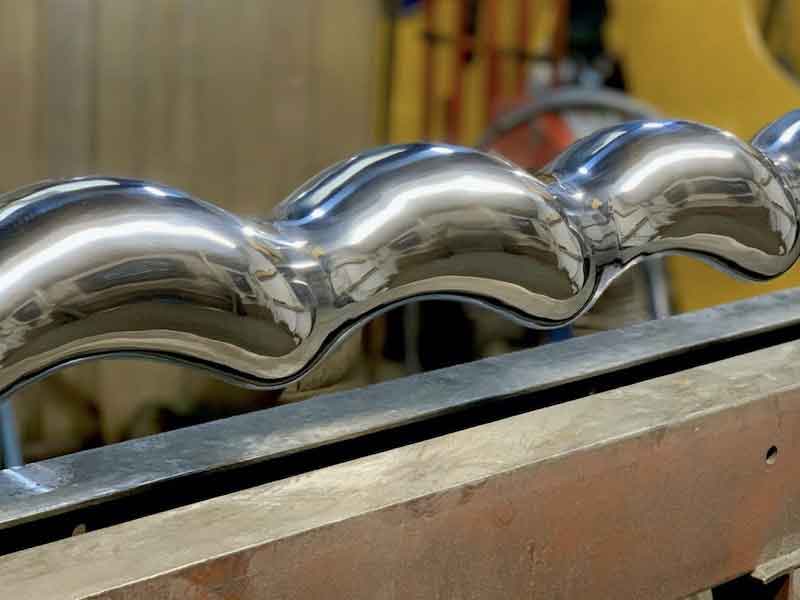When power is converted from AC to DC, the current flows in ripples. Just as a light powered by such a current would flicker, electrochemical processes are also affected, either slowing or stopping, even if just for milliseconds at a time – and undetectable by the human eye.
 Felipe AttiThis brief white paper shows how the range of fluctuation in these ripples – high or low – has a significant impact on throwing power, plating quality, and resources required for metal finishing.
Felipe AttiThis brief white paper shows how the range of fluctuation in these ripples – high or low – has a significant impact on throwing power, plating quality, and resources required for metal finishing.
Numeric Readings Only Show an Average Voltage
The voltage reading on a rectifier panel is just an average figure. What really matters is the percentage of the nominal voltage actually being used. For example, 7.3V from an 18V rectifier equals 40.4%. This chart shows the reality behind that average and what is actually going on.
Here we can see the current output via a silicon-controlled rectifier (SCR) or thyristor at 100% (in blue) and 40.4% (in dark blue). Each wave, or ripple, lasts around 3 milliseconds.
When the output voltage is 100% of the nominal, the ripples are shallow. But such high voltages would create currents too high for hard chrome plating - over 1000 to 1200 ASF (amps per square foot).
 However, at anything lower than 100%, the peaks and troughs in the power supply become more pronounced. So, at an average of 40.4%, the current ripple is actually fluctuating between 0 and around 840 ASF every 3 or so milliseconds – a huge variation that will impact plating performance.
However, at anything lower than 100%, the peaks and troughs in the power supply become more pronounced. So, at an average of 40.4%, the current ripple is actually fluctuating between 0 and around 840 ASF every 3 or so milliseconds – a huge variation that will impact plating performance.
Silicon-controlled rectifiers (SCR) do reduce the ripple effect somewhat, using expensive filters that promise a best-case scenario of 5% ripple at 100% of the nominal voltage of the equipment (worsening as the output voltage drops).
A KraftPowercon switch-mode rectifier delivers just ~1% ripple, no matter the output voltage, which is much shallower than conventional rectifiers can achieve. In this chart, the green line shows the ripple from a switch-mode rectifier.
 Both rectifiers would be showing an average voltage reading of around 44% of the nominal (for example, around 5V output from a 12V rectifier), but there is a large difference between the dark blue (SCR) and the green (switch mode).
Both rectifiers would be showing an average voltage reading of around 44% of the nominal (for example, around 5V output from a 12V rectifier), but there is a large difference between the dark blue (SCR) and the green (switch mode).
Using the switch-mode rectifier, the ripple has evened out significantly, and it never drops below 400 ASF (amps per square foot).
The Impact of Ripples on Plating Quality
Obtaining an even finish can be a challenge, especially when plating complex forms.
 For example, sharp edges attract more deposits and can create the ‘dog bone’ effect, with plating thickness widening at these edges and ends. Similarly, areas closer to the anode are more likely to attract deposits, and those further away (such as recessed areas) will be harder to plate.
For example, sharp edges attract more deposits and can create the ‘dog bone’ effect, with plating thickness widening at these edges and ends. Similarly, areas closer to the anode are more likely to attract deposits, and those further away (such as recessed areas) will be harder to plate.
The higher the fluctuation within the current ripple, the more exaggerated this effect becomes.
The following graph shows how the ripple effect impacts finishing for high current density zones (HCDZ) and low current density zones (LCDZ) when using an SCR – bearing in mind that even simply-shaped parts will have zones of higher current density than others.
When the ripple fluctuations are high, deposition is not even, resulting in low quality.
At current densities lower than 288 ASF (for hard chrome plating solutions at 130°F, shown in purple), the chromium deposit becomes milky and dull. Each time the ripple drops below the minimum threshold, nothing is deposited.
The average density is the current reading on the ammeter, divided by the total surface area of the part being plated (shown in pink).
 The current flowing to high current density zones (HCDZ) is represented by the blue line, and the lower current density zones (LCDZ) are shown in green. Within each phase of the ripple, both fall to zero, failing to meet the minimum threshold for plating.
The current flowing to high current density zones (HCDZ) is represented by the blue line, and the lower current density zones (LCDZ) are shown in green. Within each phase of the ripple, both fall to zero, failing to meet the minimum threshold for plating.
The More Extreme the Ripple Fluctuations, the Greater the Impact on Finishing Quality
This chart now compares the unfiltered ripple from a 6-pulse SCR with the performance of a switch-mode rectifier.
As we’ve already seen, with each ripple, the SCR power supply falls from 950+ ASF down to zero in both LCDZ and LHDZ. This shows that the plating action is constantly stopping, the peaks are using excessive material and power, and the troughs are dropping below the minimum threshold.
 In contrast, the switch-mode rectifier is achieving a steady 314-460 ASF. And unlike SCRs, the power supply never drops to zero.
In contrast, the switch-mode rectifier is achieving a steady 314-460 ASF. And unlike SCRs, the power supply never drops to zero.
The Impact of Improved Power Supply and Plating Quality on Production
By improving the power supply – reducing to low ripple using a switch-mode rectifier – throwing power is improved.
Plating on low current density zones will be approximately 15% thicker, accelerating processes and reducing energy consumption accordingly. There is a reduction in grinding time and effort needed for high current density zones, with approximately 12.7% less material to be removed – a significant reduction in wasted materials while cutting labor costs and production time.
 This is especially valuable when plating with hard chrome on expensive automotive and aerospace components.
This is especially valuable when plating with hard chrome on expensive automotive and aerospace components.
Awkward and complex shapes can be plated with greater success and efficiency.
In this example, using a silicon-controlled rectifier resulted in no plating to the central core surface of the helix. Once this was exchanged for a KraftPowercon switch-mode rectifier, the entire component was successfully plated – only a minimal amount of finishing was needed to remove the burn on the outer areas.
If using a switch-mode rectifier, a batch can be plated with higher quality in a shorter time than when using a conventional rectifier; the outcome will inevitably be a reduction in man-hours, energy costs, and chemical supplies used.
Visit www.kraftpowercon.com
Felipe Atti is the Senior Applications Engineer at KraftPowercon, Inc. Before joining the KraftPowercon team. He has been in the hard chrome plating business since his industrial apprenticeship training in electronics in 1991. He earned his BSc degree in Mechanical Engineering from Universidade de Caxias do Sul, Brazil, and holds an MBA degree from Fundacao Getulio Vargas, Brazil.



































